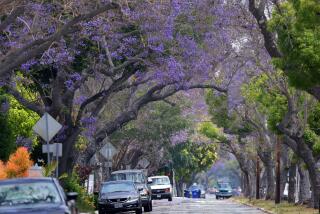Know before you grow
- Share via
Flowering trees from the Southern Hemisphere make bold seasonal statements in the landscape. Follow these guidelines when planning: Selection: Do your homework. Large trees need wide berths. Smaller ones fit in tight spaces; a few will even grow in pots. Some species thrive inland; others are best near the coast.
Placement: Most of these trees want fast-draining soil. Some need full sun; others are OK in light shade. Consider leaf drop and, more important, flower drop. Certain blossoms (jacaranda included) are slippery and sticky and can stain pavement.
Planting: Transplant these cold-sensitive trees in spring or summer but not in fall. Moved now, they may rot during winter.
Watering, feeding: Though some species are drought-tolerant, all young trees need regular irrigation and a thick layer of mulch to insulate roots and conserve moisture. Feeding needs vary by species, so check with your nursery.
Pruning: Prune these trees after flowering, as needed. Timing may vary between species and from year to year. Some, such as the floss silk tree, are best left untouched; pruning destroys the natural symmetry.
— Lili Singer
More to Read
Sign up for The Wild
We’ll help you find the best places to hike, bike and run, as well as the perfect silent spots for meditation and yoga.
You may occasionally receive promotional content from the Los Angeles Times.










